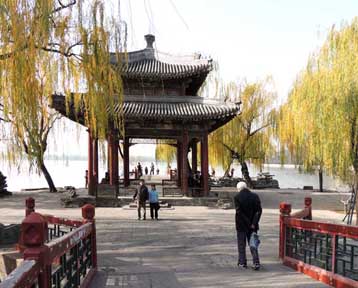China - Table of Contents..............Chinese Architecture Dictionary............ Architecture Around the World
Summer Palace
Beijing, China
Beijing, China

|
A UNESCO World Heritage Site since 1998 Listed by UNESCO as "a masterpiece of Chinese landscape garden design. The natural landscape of hills and open water is combined with artificial features such as pavilions, halls, palaces, temples and bridges to form a harmonious ensemble of outstanding aesthetic value." |
| The Summer Palace is the largest and most well-preserved royal park in China. It
greatly influences Chinese horticulture and landscape with its famous
natural views and cultural interests - a masterpiece of Chinese landscape garden design. The natural
landscape of hills and open water is combined with artificial features
such as pavilions, halls, palaces, temples and bridges. The complex is totally man-made. It is the result of the work of some 150,000 workers, craftsmen and artists who worked more than 15 years in its construction and development. Kunming Lake was created by digging a rather shallow depression with an average depth of 1.5 meters. The soil removed from the excavation was accumulated in the northern sector of the area thus creating the mount known as Longevity Hill where most of the buildings are located. The constructions of the palace, consisting of buildings, temples, halls, pavilions, gazebos, gates, archways and galleries amount to about 3000 structures and are found mainly on the Hill of Longevity and along the lake-shore. 1750-1864 - The Garden of Clear Ripples integrates numerous traditional halls and pavilions into the Imperial Garden as conceived by the Qing emperor Qianlong. It is a residence and a place to rest during the sweltering Beijing summer months. 1860 - Destroyed during the Second Opium War of the 1850s, it was reconstructed by Emperor Guangxu for use by Empress Dowager Cixi and renamed the Summer Palace. 1900 - Damaged again during the Boxer Rebellion in 1900 and repaired in the next two years. 1924 - Public park. The 100-odd examples of traditional architecture in the park include pavilions, terraces, temples, pagodas, waterside gazebos, covered corridors, stone bridges and the famous marble boat. In 1885, Empress Dowager Cixi, (a.k.a. the “Dragon Lady”) was running the government as a Regent on behalf of her nephew Zaitian who in 1875, at the age of 4, became the Guangxu Emperor, and decided to move her residence from the Forbidden City to the Summer Palace. It is said that to finance the renovation and ornamentation of the residence, and to enhance and embellish the gardens, Empress Cixi would have used resources defrauded from government funds which had been allotted for improvement of the Chinese Navy. Between 1886 and 1902 the Summer Palace was virtually rebuilt. In 1888, it received its current name, “Yihe Yuan” meaning "The Garden of Health and Harmony". |

